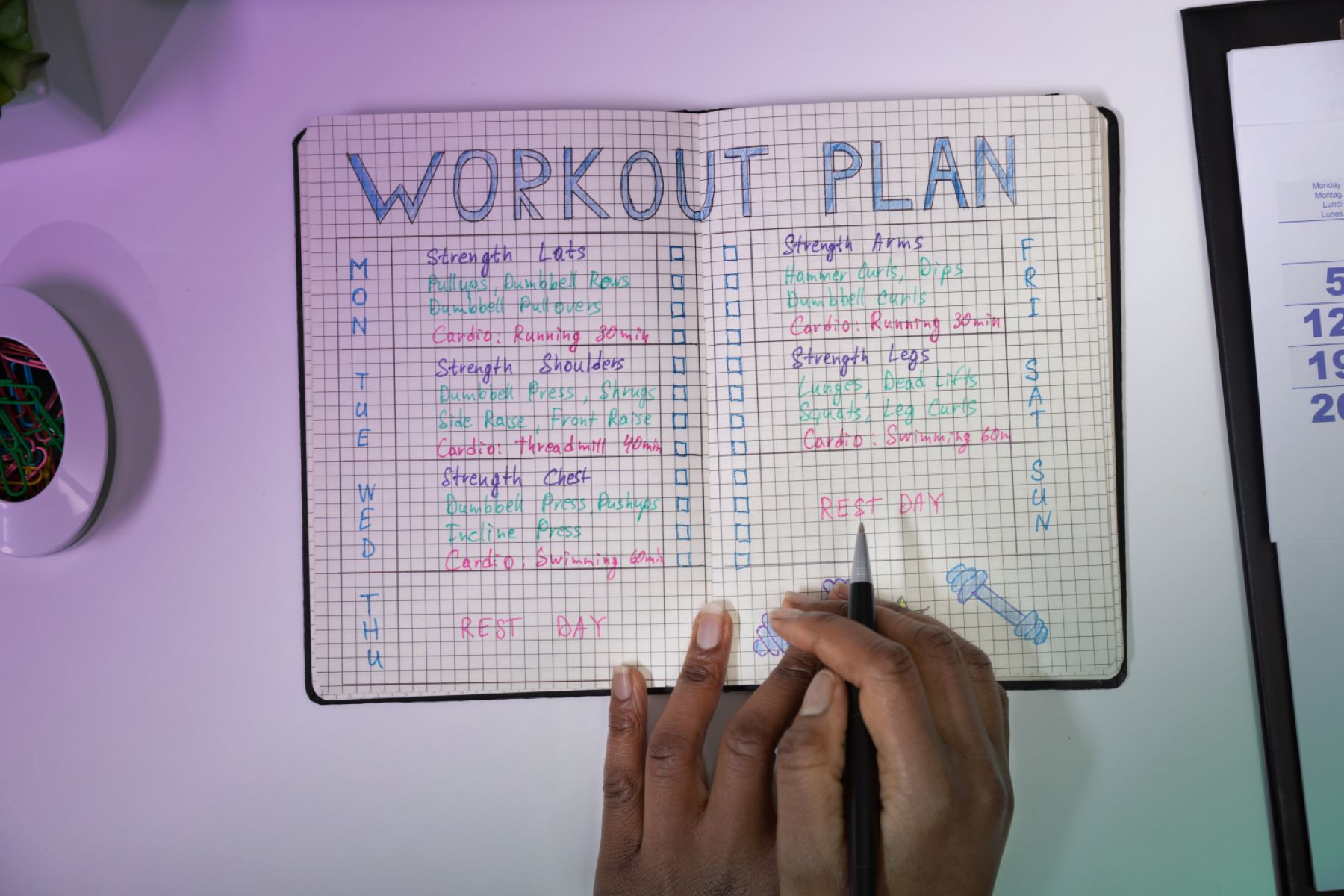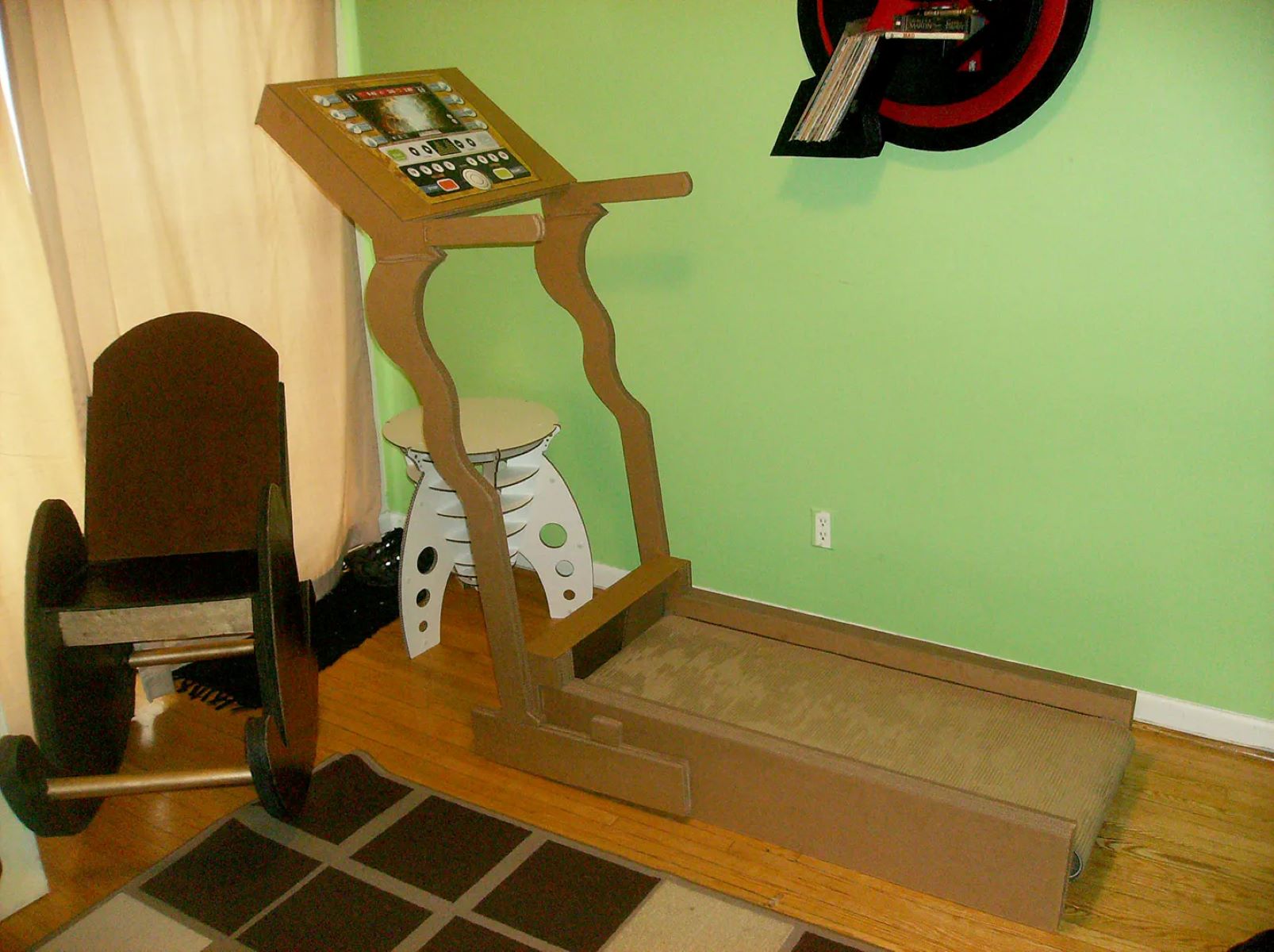

Featured
How To Create Workout Plan
Modified: August 21, 2023
Learn how to create a personalized workout plan with our featured guide. Achieve your fitness goals and stay motivated with our expert tips and advice.
Introduction
Starting a workout plan can be an exciting journey towards improved health and fitness. Whether you are a beginner looking to establish a regular exercise routine or someone with experience aiming to switch up your current workouts, creating a well-rounded workout plan is crucial to achieving your fitness goals.
Having a workout plan not only helps you stay organized and focused, but it also ensures that you engage in a variety of exercises that target different muscle groups and promote overall fitness. A well-designed workout plan takes into consideration your individual needs, preferences, and fitness level to provide you with a tailored approach to achieving your desired results.
In this article, we will guide you through the process of creating an effective workout plan that suits your needs. We will explore how to set goals, assess your fitness level, choose the right exercises, determine exercise frequency, create a structured routine, incorporate strength training, cardiovascular exercise, and flexibility training, track your progress, and stay motivated along your fitness journey.
By the end of this article, you will have a clear understanding of how to create a personalized workout plan that will not only challenge you physically, but also keep you motivated and committed to your fitness goals.
Setting Goals
Setting goals is a vital step in creating a workout plan that aligns with your aspirations and keeps you motivated along the way. By setting specific, measurable, attainable, relevant, and time-bound (SMART) goals, you can give yourself a clear direction and track your progress effectively.
Start by defining your long-term fitness goals. Do you want to lose weight, gain muscle, improve cardiovascular endurance, increase flexibility, or achieve a combination of these? Once you have a clear vision of your long-term goals, break them down into smaller, achievable milestones.
Make sure your goals are realistic and aligned with your current fitness level and lifestyle. Setting unrealistic goals can lead to frustration and disappointment. Instead, aim for gradual progress and celebrate small victories along the way.
It’s important to note that goals shouldn’t be solely focused on physical changes. Consider incorporating performance-based goals, such as running a certain distance in a specific time or being able to lift a certain amount of weight.
In addition to setting specific goals, it’s essential to attach a timeframe to each goal. Having deadlines creates a sense of urgency and accountability. For example, you may set a goal to run a 5k race in three months or to increase your bench press by 10 pounds within two months.
Lastly, write down your goals and keep them visible. This visual reminder will serve as a constant motivator, especially during times when you may feel demotivated or encounter obstacles along your fitness journey. Regularly reviewing and revisiting your goals will help you stay focused and committed to achieving them.
Remember, goal setting is a dynamic process. As you progress and achieve your initial goals, you can set new ones or adjust existing goals to keep challenging yourself and continue making progress.
Assessing Fitness Level
Before diving into a workout plan, it’s important to assess your current fitness level. This assessment will help you understand where you currently stand and determine the appropriate starting point for your workouts.
One way to assess your fitness level is by considering your overall health. Take into account any pre-existing medical conditions or injuries that may affect your ability to engage in certain exercises. It’s important to consult with a healthcare professional if you have any concerns or limitations.
Next, evaluate your cardiovascular endurance. This can be done by performing a simple fitness test like the 1-mile walk test or the 3-minute step test. These tests measure how efficiently your heart and lungs can supply oxygen to your muscles during physical activity.
Another aspect to consider is your muscular strength and endurance. You can perform exercises like push-ups, planks, squats, or resistance training exercises with weights to gauge your strength and endurance levels. This will help you understand which muscle groups may need more focus in your workout plan.
Flexibility is also an important component of fitness. Assess your flexibility by performing stretches for major muscle groups like the hamstrings, quadriceps, and shoulders. Consider your range of motion and any tight or restricted areas that may need improvement.
Additionally, evaluate your balance and coordination. Simple tests like standing on one leg or performing balance exercises can give you an idea of your current balance and coordination abilities.
Keep a record of your assessments, either in a fitness journal or using digital tracking tools. This will allow you to track your progress over time and identify areas where you may need to focus more attention in your workouts.
Assessing your fitness level before starting a workout plan not only helps you set realistic goals, but it also assists in determining the appropriate intensity and progression for your exercises. Remember, everyone has a different starting point, and it’s important to work at a level that is challenging but safe for your individual needs.
Choosing the Right Exercises
When designing a workout plan, it’s crucial to select exercises that align with your goals, fitness level, and preferences. Incorporating a variety of exercises will not only keep your workouts interesting, but it will also ensure that you target different muscle groups and improve overall fitness.
Start by identifying exercises that specifically address your goals. For example, if your goal is to build strength, consider incorporating compound exercises like squats, deadlifts, and bench presses. If weight loss is your focus, prioritize cardiovascular exercises such as running, cycling, or swimming.
Consider your fitness level and choose exercises that challenge you without causing undue strain or risk of injury. If you are a beginner, it may be wise to start with bodyweight exercises or low-impact activities before progressing to more advanced movements or high-impact exercises.
Don’t be afraid to try new exercises or different workout modalities. Experimenting with different types of exercises, such as yoga, Pilates, dance, or martial arts, can bring variety to your routine and help you discover activities that you truly enjoy.
Remember to focus on both major muscle groups and smaller, stabilizing muscles. Aim for a well-rounded workout that includes exercises for your upper body, lower body, core, and back. This balanced approach will improve overall strength and stability.
Furthermore, consider incorporating functional exercises that mimic movements you do in your daily life. This can enhance your ability to perform everyday tasks more effectively and reduce the risk of injury. Examples of functional exercises include squats, lunges, push-ups, and planks.
Lastly, listen to your body and be aware of any discomfort or pain. If an exercise causes pain or doesn’t feel right for your body, modify it or seek guidance from a fitness professional to ensure proper form and technique.
Remember, the key is to create a workout plan that is challenging, enjoyable, and sustainable for your personal needs and goals. By choosing the right exercises, you will maximize your progress and maintain a long-term commitment to your fitness journey.
Determining Exercise Frequency
Determining the frequency of your workouts is essential to creating a balanced and effective workout plan. The right exercise frequency will depend on your goals, fitness level, schedule, and recovery abilities.
First, consider your fitness goals. If your primary goal is to improve cardiovascular fitness or lose weight, you may need to engage in more frequent sessions of aerobic exercise. On the other hand, if your goal is to build strength or muscle mass, allowing for more recovery time between workouts may be beneficial.
Take into account your current fitness level. Beginners may benefit from starting with 2-3 days of exercise per week and gradually increasing frequency as their fitness improves. More experienced individuals can aim for 4-6 days per week, including a mix of strength training, cardiovascular exercise, and flexibility training.
Consider your schedule and availability. Find a balance between challenging yourself and being realistic about the time you can commit to exercise. Even if you have a busy schedule, incorporating short, intense workouts or finding pockets of time throughout the day for physical activity can still be beneficial.
Recovery is a vital aspect of any workout plan. Adequate rest and recovery allow your muscles to repair and grow stronger. It’s important to factor in rest days throughout the week to give your body time to recover. This could mean taking one or two complete days off from exercise, or engaging in active recovery activities such as gentle stretching or low-intensity workouts.
Furthermore, pay attention to your body’s response to exercise. If you consistently feel fatigued, sore, or experience an increased risk of injury, it may be a sign that you are overtraining. Be willing to adjust your workout frequency and intensity as needed to prevent burnout and maintain overall health and well-being.
Ultimately, finding the right exercise frequency is about striking a balance between pushing your limits and allowing your body to recover. Experiment with different frequencies and listen to your body to determine what works best for you.
Remember, consistency is key. It’s better to have a realistic and sustainable exercise frequency that you can stick to in the long run, rather than overdoing it and risking injury or losing motivation. Focus on finding a routine that you enjoy and that fits seamlessly into your lifestyle.
Creating a Structured Routine
A structured routine is the backbone of a successful workout plan. It provides organization, consistency, and a clear roadmap to follow. When creating your routine, consider the following factors to ensure a well-rounded and balanced approach to your workouts.
First, determine the duration of each workout session. This will depend on your fitness goals, available time, and personal preferences. A typical session can range from 30 minutes to an hour or more. Be realistic about the amount of time you can dedicate to exercise and make the most of the time you have.
Next, consider the type of workouts you will include in your routine. Aim for variety by incorporating different types of exercises, such as strength training, cardiovascular exercise, and flexibility training. This will help target different muscle groups and improve overall fitness.
Decide on the order of exercises within each session. Some prefer to start with a warm-up, followed by cardiovascular exercise, strength training, and ending with stretching. Others may prefer to alternate between different types of exercises to keep the workout engaging and challenging.
Don’t forget to include rest intervals between sets or exercises. This allows your body to recover and ensures that you can maintain proper form and technique throughout your workouts. Rest intervals can vary depending on the intensity of the exercise and your fitness level.
Additionally, consider the frequency of each exercise. For example, you may choose to perform strength training exercises two to three times per week, cardiovascular exercise four to five times per week, and flexibility training every day or on alternate days.
Remember to schedule rest or recovery days into your routine. This will give your body time to repair and regenerate, reducing the risk of overtraining and promoting long-term progress. Use these days to focus on active recovery activities or engage in leisurely physical activities.
Flexibility is key when creating a structured routine. Life can be unpredictable, and there may be days when you are unable to follow your planned workout. Adaptability allows you to make necessary adjustments or modifications without feeling discouraged or derailed from your fitness journey.
Consider using a journal, digital planner, or fitness app to record your structured routine. This will help you stay accountable and provide an overview of your progress over time. It can also be motivating to see how far you’ve come and how your routine has evolved.
Remember that creating a structured routine is not set in stone. Be open to evaluating and adjusting your routine as needed. Listen to your body, reassess your goals, and make modifications that will keep you challenged and motivated.
Having a structured routine will provide you with a sense of direction, consistency, and organization in your fitness journey. Embrace the routine as a tool to help you reach your goals and stay on track towards a healthier, fitter you.
Incorporating Strength Training
Strength training is a vital component of any well-rounded workout plan. It helps build lean muscle mass, improves overall strength and power, increases metabolism, and enhances body composition. Incorporating strength training into your routine has numerous benefits that can support your fitness goals, whether it’s building muscle, burning fat, or improving athletic performance.
When incorporating strength training into your workout plan, consider the following key factors:
Exercise Selection: Choose a variety of exercises that target different muscle groups. This includes compound exercises that work multiple muscle groups simultaneously, such as squats, deadlifts, bench presses, and shoulder presses, as well as isolation exercises that focus on specific muscles, like bicep curls or lateral raises.
Resistance: To build strength and muscle, use an appropriate level of resistance. This can be achieved through free weights, weight machines, resistance bands, or even your bodyweight. Gradually increase the weight or resistance over time to continue challenging your muscles.
Repetitions and Sets: The number of repetitions (reps) and sets you perform will depend on your goals and fitness level. For strength and muscle building, aim for higher intensity with lower repetitions (6-8 reps) and multiple sets (3-4 sets). If your goal is muscular endurance or toning, use lighter weights with higher repetitions (12-15 reps) and more sets.
Rest Intervals: Allow for adequate rest between sets to allow your muscles to recover. Shorter rest periods (30-60 seconds) promote muscular endurance, while longer rest periods (1-2 minutes) allow for greater strength recovery between sets.
Progressive Overload: Continually challenge your muscles by gradually increasing the weight, repetitions, or number of sets over time. This progressive overload stimulates muscle growth and prevents plateauing in your strength gains.
Form and Technique: Proper form and technique are essential for maximizing the effectiveness of your strength training exercises and minimizing the risk of injury. If you’re new to strength training, consider working with a qualified fitness professional or using resources such as instructional videos to ensure you’re using correct form.
Frequency: Aim to include strength training exercises 2-3 times per week, with at least one day of rest in between sessions. This allows your muscles time to recover and adapt to the stress of the workouts.
Remember, strength training should be challenging, but always listen to your body and adjust the intensity or weight as needed. Gradually increase the weights and intensity as you become comfortable with the exercises and your fitness level improves.
Incorporating strength training into your workout plan will not only improve your physical strength and appearance, but it will also enhance your overall health, metabolism, bone density, and quality of life. Embrace the benefits of strength training and make it an essential part of your fitness routine.
Incorporating Cardiovascular Exercise
Cardiovascular exercise, often referred to as cardio or aerobic exercise, plays a significant role in a well-rounded workout plan. It helps improve cardiovascular health, increases endurance, burns calories, and supports weight management. Incorporating cardiovascular exercise into your routine offers numerous benefits for both your physical and mental well-being.
When incorporating cardiovascular exercise into your workout plan, consider the following key factors:
Choose Activities You Enjoy: Select activities that you genuinely enjoy and that align with your fitness goals and preferences. This could include running, cycling, swimming, dancing, brisk walking, or participating in group fitness classes. When you enjoy the activity, you’re more likely to engage in it consistently.
Vary Your Intensity: Incorporate different intensities of cardio exercise to challenge your cardiovascular system and vary your calorie-burning potential. High-intensity interval training (HIIT), which involves alternating periods of high-intensity work with periods of recovery, can be an effective way to improve cardiovascular fitness and burn calories in a shorter amount of time.
Duration and Frequency: Aim for at least 150 minutes of moderate-intensity aerobic exercise or 75 minutes of vigorous-intensity aerobic exercise per week. This can be spread out over several sessions. If you’re just starting, begin with shorter sessions and gradually increase the duration and intensity.
Warm-Up and Cool-Down: Prioritize a proper warm-up and cool-down before and after your cardiovascular workouts. This helps prepare your body for exercise and reduces the risk of injury. Warm-up activities may include light jogging, jumping jacks, or dynamic stretching, while cool-down activities may consist of a slow walk, stretching, or foam rolling.
Monitor Intensity: Pay attention to your perceived exertion level during cardio workouts. Use a scale of 1-10 to rate your intensity level, with 1 being very light and 10 being maximal effort. Aim to maintain a moderate to vigorous intensity to maximize your cardiovascular fitness and calorie burn.
Combine Cardio with Strength Training: For optimal results, incorporate cardiovascular exercise with strength training. A combination of both types of exercise provides a well-rounded fitness routine that improves overall endurance, strength, and body composition. Consider alternating days or incorporating both types of exercise in the same session.
Stay Consistent: Consistency is key when it comes to cardiovascular exercise. Aim for regular sessions throughout the week and make it a habit in your daily routine. This will help you reap the long-term benefits of improved cardiovascular health, weight management, and increased energy levels.
Remember, cardiovascular exercise should be challenging, but always listen to your body and adjust the intensity or duration as needed. Gradually progress the intensity and duration of your workouts to continue challenging your cardiovascular system.
Incorporating cardiovascular exercise into your workout plan will not only enhance your physical fitness but also boost your mood, reduce stress, and improve overall well-being. Embrace the benefits of cardio and make it a regular part of your fitness routine.
Incorporating Flexibility Training
Flexibility training is a valuable and often overlooked component of a well-rounded workout plan. It helps improve joint range of motion, posture, muscle elasticity, and overall mobility. Incorporating flexibility exercises into your routine offers numerous benefits for both your physical performance and injury prevention.
When incorporating flexibility training into your workout plan, consider the following key factors:
Stretching Techniques: Choose appropriate stretching techniques that target different muscle groups. Static stretching involves holding a stretch for a certain duration, while dynamic stretching involves moving through a range of motion. Both techniques have their benefits and can be used in combination to enhance flexibility.
Include Both Active and Passive Stretching: Active stretching involves using your own muscles to move a joint through its full range of motion, while passive stretching involves using external force or assistance, such as a strap or partner, to achieve a stretch. Incorporating both types of stretching can help improve flexibility effectively.
Focus on Major Muscle Groups: Emphasize stretching major muscle groups such as hamstrings, quadriceps, hip flexors, calves, chest, shoulders, and back. These areas are commonly tight due to daily activities or imbalances caused by certain exercises. Pay attention to areas that are prone to stiffness or tightness in your own body.
Gradual Progression: Begin with gentle stretches and gradually increase the intensity and duration over time. Avoid bouncing or forcing a stretch, as this can lead to injury. Hold each stretch for 15-30 seconds and repeat each stretch two to three times. Listen to your body and avoid any painful or discomforting stretches.
Incorporate Flexibility Exercises: Consider including exercises like yoga or Pilates in your routine. These activities not only improve flexibility but also enhance strength, balance, and body awareness. They provide a holistic approach to fitness and promote overall well-being.
Stretch During Warm-Up and Cool-Down: Incorporate stretching exercises during your warm-up and cool-down sessions. This helps prepare your muscles for exercise, increases blood flow, and reduces the risk of injury. It’s important to note that static stretching is best done after your workout or as a separate session, as it can temporarily decrease muscle strength if performed before intense activity.
Mindfulness and Relaxation: Flexibility training can also provide an opportunity for mindfulness and relaxation. Use this time to focus on your breathing, release tension, and quiet your mind. Incorporate deep breathing exercises or meditation techniques to enhance the mind-body connection.
Consistency is Key: Regularity is essential in improving and maintaining flexibility. Aim to incorporate flexibility training at least two to three times per week. Consistent practice over time will yield greater flexibility gains and help prevent muscle imbalances and tightness.
Remember, flexibility training should be gentle and comfortable. Avoid pushing your body beyond its limits and respect your individual flexibility level. With consistency and patience, you’ll gradually notice improvements in your range of motion and overall flexibility.
Incorporating flexibility training into your workout plan will not only enhance your physical performance but also promote better posture, reduce the risk of injuries, and improve your overall quality of movement. Embrace the benefits of flexibility training and make it an integral part of your fitness routine.
Tracking Progress
Tracking your progress is essential when it comes to evaluating the effectiveness of your workout plan and staying motivated along your fitness journey. Whether your goal is to lose weight, build strength, or improve overall fitness, monitoring your progress provides valuable insights and helps you make necessary adjustments to your routine. Here are some key steps to effectively track your progress:
Set Measurable Goals: Start by setting specific and measurable goals. This could include targets like losing a certain amount of weight or body fat, increasing the number of push-ups you can do, or improving your running pace. Having clear goals allows you to track your progress and celebrate achievements along the way.
Keep a Fitness Journal: One effective method of tracking progress is to maintain a fitness journal. Write down your workouts, including the exercises, sets, reps, and weights used. Note any challenges or improvements you experience. Additionally, journaling can help you identify patterns, set benchmarks, and reflect on your progress over time.
Utilize Technology: There are numerous fitness tracking apps, wearable devices, and online platforms available that can assist in monitoring various aspects of your fitness journey. These tools can track metrics such as distance covered, calories burned, heart rate, and even sleep patterns. Find a tracking method that suits your preferences and utilize it consistently.
Measure Body Metrics: Regularly measuring and tracking body metrics such as weight, body fat percentage, waist circumference, and muscle measurements can provide objective data on your progress. Remember that the scale is not the only measure of progress, as it doesn’t account for changes in body composition and muscle growth. Take measurements at consistent intervals to track changes accurately.
Assess Performance Improvements: Record improvements in your performance, such as increased strength, endurance, or flexibility. Track the number of repetitions, weights lifted, running pace, or the time it takes to complete certain exercises. This objective feedback can be highly motivating and serve as a reminder of your progress.
Take Progress Photos: Progress photos can visually capture changes in your body composition over time. Take photos from the front, side, and back at regular intervals, under consistent lighting conditions and in similar clothing. Comparing these photos side by side can provide a visual representation of your progress.
Celebrate Milestones: Recognize and celebrate milestones along your fitness journey. Whether it’s reaching a certain weight, completing a challenging workout, or achieving a personal best, acknowledging your achievements can boost motivation and reinforce the positive changes you have made.
Reevaluate and Adjust: Regularly evaluate your progress and adjust your workout plan accordingly. If you’re not seeing the desired results, consider making changes to your exercise selection, intensity, or frequency. Be open to seeking guidance from fitness professionals who can provide insights and recommendations.
Tracking your progress not only provides a sense of achievement but also helps identify areas for improvement. It allows you to make informed decisions about your workout plan and make adjustments as needed. Remember, progress is not always linear, and there may be ups and downs along the way. Stay committed, trust the process, and continue striving towards your fitness goals.
Staying Motivated
Staying motivated is a key factor in maintaining a consistent and successful workout routine. It can be challenging at times to stay on track and prioritize exercise, but with the right strategies and mindset, you can find the inspiration and drive to keep going. Here are some effective ways to stay motivated:
Set Realistic and Specific Goals: Having clear, realistic, and achievable goals provides a sense of purpose and direction. Break your big goals into smaller milestones and celebrate each achievement along the way. This will keep you motivated and give you a sense of accomplishment as you make progress.
Find Your Why: Reflect on your reasons for wanting to exercise and stay fit. Whether it’s improving your health, gaining confidence, setting a positive example for others, or simply feeling good in your own skin, identifying your personal motivations will keep you focused and committed when motivation wanes.
Establish a Routine: Incorporate exercise into your daily or weekly routine to make it a habit. Schedule your workouts and treat them as non-negotiable appointments with yourself. Making exercise a consistent part of your routine will reduce the chances of skipping workouts and help build discipline.
Mix it Up: Variety is the spice of life, and the same goes for your workouts. Incorporate a variety of exercises, try new activities, or join group classes to keep your workouts engaging and exciting. Boredom is one of the biggest demotivators, so mix up your routine to keep things fresh and challenging.
Find Accountability: Find a workout buddy, join a fitness community, or hire a personal trainer. Having someone to exercise with or who holds you accountable can make a significant difference in staying motivated. It’s harder to skip a workout when you know someone is counting on you or when you have someone to share your fitness journey with.
Reward Yourself: Treat yourself to rewards when you reach milestones or achieve your goals. It could be a new workout outfit, a massage, a day off, or anything that brings you joy and reinforces your hard work. Celebrating your achievements boosts motivation and gives you something to look forward to.
Track Your Progress: Keeping track of your progress, as we discussed in the previous section, is not only a way to measure results but also an effective motivator. Seeing how far you’ve come and the improvements you’ve made can inspire you to keep pushing forward.
Find Inspiration: Surround yourself with sources of inspiration. Follow fitness influencers on social media, read success stories, watch motivational videos, or listen to podcasts that focus on health and well-being. Engaging with positive and uplifting content can help fuel your motivation.
Practice Self-Care: Taking care of your overall well-being is important for staying motivated. Prioritize rest, proper nutrition, and recovery to avoid burnout and keep your energy levels high. Listen to your body and give yourself permission to rest when needed.
Celebrate Non-Physical Benefits: Don’t solely focus on physical changes. Pay attention to how exercise makes you feel mentally, emotionally, and spiritually. Recognize the stress relief, improved mood, increased energy, and overall sense of well-being that exercise brings. These non-physical benefits can be powerful motivators.
Remember, motivation comes and goes, but discipline is what keeps you going when motivation fades. Cultivating healthy habits, finding your why, and incorporating strategies that resonate with you will help you maintain the motivation needed to stay committed to your fitness journey.
Conclusion
Creating a personalized and effective workout plan is crucial for achieving your fitness goals and maintaining a healthy lifestyle. By following the steps outlined in this article, you can create a well-rounded routine that incorporates strength training, cardiovascular exercise, flexibility training, and proper goal setting. Each component is essential for improving overall fitness, building strength, increasing endurance, and promoting overall well-being.
Remember to regularly assess your fitness level, set realistic goals, and choose exercises that align with your objectives and preferences. Determine the appropriate exercise frequency that suits your schedule and allows for proper recovery. Create a structured routine that provides organization and consistency, and incorporate strength training to build muscle and improve strength. Don’t forget the importance of cardiovascular exercise for enhancing endurance and burning calories.
Incorporating flexibility training into your routine is essential for improving joint mobility, preventing injuries, and maintaining optimal physical function. Track your progress using various methods such as keeping a fitness journal, using technology, measuring body metrics, and assessing performance improvements. Stay motivated by setting realistic goals, finding your why, establishing a routine, finding accountability, and rewarding yourself along the way. Stay inspired, practice self-care, and celebrate the non-physical benefits of exercise.
Ultimately, your fitness journey is a personal one that requires dedication, consistency, and the willingness to adapt as needed. Embrace the process, stay committed, and enjoy the physical and mental benefits that come with a well-designed workout plan. Remember, your fitness journey is a marathon, not a sprint. Progress may come in small increments, but with patience and perseverance, you can achieve your desired fitness goals and maintain a healthy and active lifestyle for years to come.









